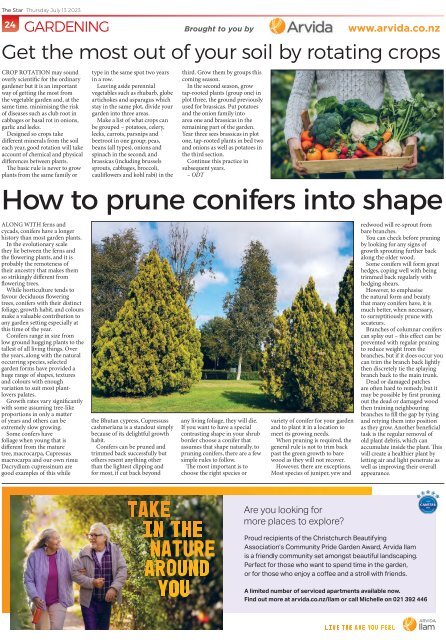The Star: July 13, 2023
Create successful ePaper yourself
Turn your PDF publications into a flip-book with our unique Google optimized e-Paper software.
<strong>The</strong> <strong>Star</strong> Thursday <strong>July</strong> <strong>13</strong> <strong>2023</strong><br />
24<br />
GARDENING<br />
CROP ROTATION may sound<br />
overly scientific for the ordinary<br />
gardener but it is an important<br />
way of getting the most from<br />
the vegetable garden and, at the<br />
same time, minimising the risk<br />
of diseases such as club root in<br />
cabbages or basal rot in onions,<br />
garlic and leeks.<br />
Designed so crops take<br />
different minerals from the soil<br />
each year, good rotation will take<br />
account of chemical and physical<br />
differences between plants.<br />
<strong>The</strong> basic rule is never to grow<br />
plants from the same family or<br />
type in the same spot two years<br />
in a row.<br />
Leaving aside perennial<br />
vegetables such as rhubarb, globe<br />
artichokes and asparagus which<br />
stay in the same plot, divide your<br />
garden into three areas.<br />
Make a list of what crops can<br />
be grouped – potatoes, celery,<br />
leeks, carrots, parsnips and<br />
beetroot in one group; peas,<br />
beans (all types), onions and<br />
spinach in the second; and<br />
brassicas (including brussels<br />
sprouts, cabbages, broccoli,<br />
cauliflowers and kohl rabi) in the<br />
Brought to you by<br />
third. Grow them by groups this<br />
coming season.<br />
In the second season, grow<br />
tap-rooted plants (group one) in<br />
plot three, the ground previously<br />
used for brassicas. Put potatoes<br />
and the onion family into<br />
area one and brassicas in the<br />
remaining part of the garden.<br />
Year three sees brassicas in plot<br />
one, tap-rooted plants in bed two<br />
and onions as well as potatoes in<br />
the third section.<br />
Continue this practice in<br />
subsequent years.<br />
– ODT<br />
www.arvida.co.nz<br />
Get the most out of your soil by rotating crops<br />
How to prune conifers into shape<br />
ALONG WITH ferns and<br />
cycads, conifers have a longer<br />
history than most garden plants.<br />
In the evolutionary scale<br />
they lie between the ferns and<br />
the flowering plants, and it is<br />
probably the remoteness of<br />
their ancestry that makes them<br />
so strikingly different from<br />
flowering trees.<br />
While horticulture tends to<br />
favour deciduous flowering<br />
trees, conifers with their distinct<br />
foliage, growth habit, and colours<br />
make a valuable contribution to<br />
any garden setting especially at<br />
this time of the year.<br />
Conifers range in size from<br />
low ground hugging plants to the<br />
tallest of all living things. Over<br />
the years, along with the natural<br />
occurring species, selected<br />
garden forms have provided a<br />
huge range of shapes, textures<br />
and colours with enough<br />
variation to suit most plantlovers<br />
palates.<br />
Growth rates vary significantly<br />
with some assuming tree-like<br />
proportions in only a matter<br />
of years and others can be<br />
extremely slow growing.<br />
Some confers have<br />
foliage when young that is<br />
different from the mature<br />
tree, macrocarpa, Cupressus<br />
macrocarpa and our own rimu<br />
Dacrydium cupressinum are<br />
good examples of this while<br />
the Bhutan cypress, Cupressuss<br />
cashmeriana is a standout simply<br />
because of its delightful growth<br />
habit.<br />
Conifers can be pruned and<br />
trimmed back successfully but<br />
others resent anything other<br />
than the lightest clipping and<br />
for most, if cut back beyond<br />
any living foliage, they will die.<br />
If you want to have a special<br />
contrasting shape in your shrub<br />
border choose a conifer that<br />
assumes that shape naturally. to<br />
pruning conifers, there are a few<br />
simple rules to follow.<br />
<strong>The</strong> most important is to<br />
choose the right species or<br />
variety of conifer for your garden<br />
and to plant it in a location to<br />
meet its growing needs.<br />
When pruning is required, the<br />
general rule is not to trim back<br />
past the green growth to bare<br />
wood as they will not recover.<br />
However, there are exceptions.<br />
Most species of juniper, yew and<br />
redwood will re-sprout from<br />
bare branches.<br />
You can check before pruning<br />
by looking for any signs of<br />
growth sprouting further back<br />
along the older wood.<br />
Some conifers will form great<br />
hedges, coping well with being<br />
trimmed back regularly with<br />
hedging shears.<br />
However, to emphasise<br />
the natural form and beauty<br />
that many conifers have, it is<br />
much better, when necessary,<br />
to surreptitiously prune with<br />
secateurs.<br />
Branches of columnar conifers<br />
can splay out – this effect can be<br />
prevented with regular pruning<br />
to reduce weight from the<br />
branches, but if it does occur you<br />
can trim the branch back lightly<br />
then discretely tie the splaying<br />
branch back to the main trunk.<br />
Dead or damaged patches<br />
are often hard to remedy, but it<br />
may be possible by first pruning<br />
out the dead or damaged wood<br />
then training neighbouring<br />
branches to fill the gap by tying<br />
and retying them into position<br />
as they grow. Another beneficial<br />
task is the regular removal of<br />
old plant debris, which can<br />
accumulate inside the plant. This<br />
will create a healthier plant by<br />
letting air and light penetrate as<br />
well as improving their overall<br />
appearance.


















